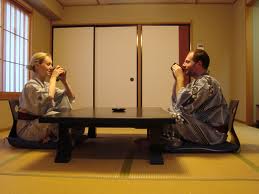Like this post? Help us by sharing it!
 A Japanese tea ceremony is about tea only on its surface. From the positioning of guests to the cleaning of the tools to the scooping of the loose-leaf tea, everything has significance. The deeper purpose of the tea ceremony is appreciation – of the items served, of the efforts made by the host, and of other guests. That appreciation starts at the most basic level, by observing the rules of etiquette.
A Japanese tea ceremony is about tea only on its surface. From the positioning of guests to the cleaning of the tools to the scooping of the loose-leaf tea, everything has significance. The deeper purpose of the tea ceremony is appreciation – of the items served, of the efforts made by the host, and of other guests. That appreciation starts at the most basic level, by observing the rules of etiquette.
Basic Etiquette
A few simple rules, two of which are highly-regarded all over Japan, should be observed when attending a tea ceremony.
- Be on time.
- Remove your shoes. Your host will provide slippers.
- Wear appropriate clothing. While, traditionally, the appropriate clothing for a tea ceremony is kimono, Western conservative wear is also acceptable, but kimono will always be appreciated.
Tea Room Etiquette
Once inside a tea room, there are a few additional rules that apply.
- Let the host seat you.
- Enter on your knees. Avoid stepping on the center of the mats. Use closed fists when touching the mats, instead of palms (for hygiene).
- Turn the cup slightly when it is passed to you to avoid drinking from the front where the last guest’s lips touched (for hygiene).
- Eat what is given to you.
Showing Appreciation
The positioning of guests in a tea room is important, and there will always by a main guest, known as the Shokyaku. This guest has the important job of communicating with the host, and showing appreciation for the host’s efforts.
Even when you are not the main guest, you should be focused on appreciation. Look at everything around the room. These things were chosen specifically and placed with care. Find something to compliment or to ask a question about – the tea, the cup, the scrolls or flowers – and pass the message through the Shokyaku. Don’t flatter the host. Find something you are generally curious about and be sincere.
In Japan, you will find plenty of drinking with lesser significance, and you can do your raucous partying outside the walls of the tea room. Since the tea ceremony is about appreciation, when you’re at a ceremony, pay attention to the things that are immediately with you and open your eyes. Appreciate those around you. Don’t let the conversation stray from the ceremony itself. By taking in your surroundings, the flavor of the tea, and the efforts of your host, you will leave with something greater than just your thirst quenched.


